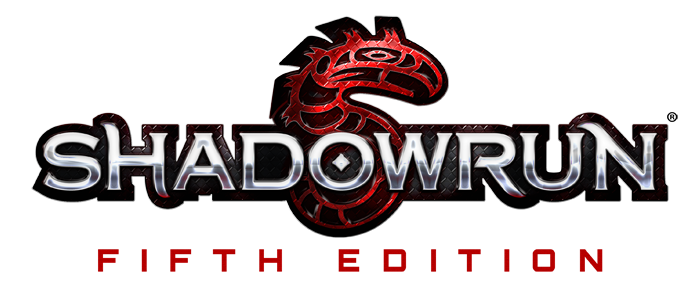
When the Shadowrun development team gathered in the secret headquarters of Catalyst Game Labs (okay, in a pleasant living room near Seattle) to discuss Shadowrun, Fifth Edition, one of the first questions why had to answer was: Why? That was a simple one: Because we wanted to. But then the questions got more complicated.
Such as this: What are the guiding principles of the new edition? That one was stickier, which is why it was a good thing that there was a fridge full of sodas nearby. Here’s what we came up with.
- We like Shadowrun, Fourth Edition. In our minds, Fourth Edition did a lot of things right. The rules were more streamlined and easier to use than ever. Having Attribute + Skill as the basis for dice pools is good. Fixed target numbers are good. And many other things are good. We wanted to be sure the strengths of Fourth Edition remained in place.
- Everything has a price. As we talked about Shadowrun, it became increasingly clear that this is a central issue facing shadowrunners. Everything they do is a trade-off of some sort. They trade the safety and security of a corporate job for the freedom of an independent life. They put their lives on the line in exchange for the chance to make a big score. They trade a piece of their soul for bleeding-edge gear to make them better, stronger, faster. All these choices bring them benefits in the end, but all of them have a price. That should be reflected in the rules. Runners should be able to get benefits they need—if they are willing to pay what those benefits cost. Nothing should be free.
- Players are the heroes. The success of a player character should be based on who they are and what they can do—the Attributes at their core and the Skills they’ve worked hard to improve. That’s where their dice should come from as much as possible. And when we’re designing plots and adventures, the focus should be on shadowrunners doing awesome things, not being players in someone else’s story.
- Amp up the cyberpunk. We love the cyberpunk Shadowrun started with, but we also realize that a lot has changed since the days when cyberpunk first took root. While it’s true that some of the genre tropes are dated, there are pieces of it that still resonate. Like a distrust of authority. The battle of individuals against dehumanizing institutions. Technology as both a tool and a threat. And a dystopian world where it’s a struggle to survive with at least a piece of your soul intact. We want the rules and the setting to reflect this atmosphere.
- Make it awesome. Shadowrunning should be dangerous, it should be difficult, but it should also provide players the chance to do impossible and amazing things. There should be dice rolls that make everyone at the table whoop with surprise, excitement, or possibly dismay. These rolls should form the basis for stories told years later. If you want to try something dangerous but just crazy enough to work, the rules should help you find a way to make that happen.
Those are the goals. How did we implement them? That’s what we’ll be discussing in future blog posts. How well did we do? You’ll be the judge of that!
A note on the different Shadowrun games coming down the pike
The initial declaration of the Year of Shadowrun included announcements of a card game (Shadowrun: Crossfire), a minis game (Shadowrun: Sprawl Gangers), and a board game (Shadowrun: Hostile Takeover). That, quite naturally, led to some questions. How were all the games going to relate to each other? Did the fact that we were doing a miniature game mean Fifth Edition was going to be more minis focused?
We can’t answer all the relevant questions here (partly because we haven’t been able to read them all yet), but we can offer a few re-assurances. First, all of the developers of the games are committed to making the games feel like Shadowrun. It’s not just a matter of putting the right pictures on some random game—the rules of each game should pick up elements of Shadowrun rules and atmosphere so that they all feel they belong together. Second, despite this relationship, the properties stand alone. The card game is it’s own thing, and the cards will not be part of the role-playing game. The minis game is also separate, and Fifth Edition does not have an increased focus on minis.
And third, we want to share more info with you. There’s already been one development blog posted about the card game, and there will be development blogs about all of the upcoming games so you can get a look under the hood and read what we’re thinking. We hope this will get you as excited about these games as we are!





